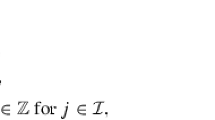Abstract
This paper aims to solve a class of CEC benchmark constrained optimization problems that have been widely studied by nature-inspired optimization algorithms. Based on canonical duality theory, these challenging problems can be reformulated as a unified canonical dual problem over a convex set, which can be solved deterministically to obtain global optimal solutions in polynomial time. Applications are illustrated by some well-known CEC benchmark problems, and comparisons with other methods have demonstrated the effectiveness of the proposed approach.

Similar content being viewed by others
References
Anstreicher, K.M.: Semidefinite programming versus the reformulation-linearization technique for nonconvex quadratically constrained quadratic programming. J. Glob. Optim. 43, 471–484 (2009)
Audet, C., Hansen, P., Jaumard, B., Savard, G.: A branch and cut algorithm for nonconvex quadratically constrained quadratic programming. Math. Progr. 87(1), 131–152 (2000)
Bao, X.W., Sahinidis, N.V., Tawarmalani, M.: Semidefinite relaxations for quadratically constrained quadratic programming: a review and comparisons. Math. Progr. 129(1), 129–157 (2011)
Bazaraa, M.S., Sherali, H.D., Shetty, C.M.: Nonlinear Programmming: Theory and Algorithms, 3rd edn. Wiley, New York (2006)
Boyd, S., Vandenberghe, L.: Convex Optimization. Cambridge University Press, Cambridge (2004)
Coello, C.A.C.: Theoretical and numerical constraint-handling techniques used with evolutionary algorithms: a survey of the state of the art. Comput. Methods Appl. Mech. Eng. 191, 1245–1287 (2002)
Cottle, R.W.: Manifestations of Schur complement. Linear Algebra Appl. 8, 189–211 (1974)
Fang, S.C., Gao, D.Y., Sheu, R.L., Wu, S.Y.: Canonical dual approach for solving 0–1 quadratic programming problems. J. Ind. Manag. Optim. 4, 125–142 (2008)
Gao, D.Y., Strang, G.: Geometric nonlinearity: potential energy, complementary energy, and the gap function. Q. J. Appl. Math. XLVII(3), 487–504 (1989)
Gao, D.Y.: Canonical duality theory and solutions to constrained nonconvex quadratic programming. J. Glob. Optim. 29(4), 377–399 (2004)
Gao, D.Y., Ruan, N., Sherali, H.D.: Solutions and optimality criteria for nonconvex constrained global optimization problems with connections between canonical and Lagrangian duality. J. Glob. Optim. 45, 473–497 (2009)
Gao, D.Y.: Caonical duality theory: Unified understanding and generalized solution for global optimization problems. Comp. Chem. Eng. 33, 1964–1972 (2009)
Gao, D.Y., Sherali, H.D.: Canonical duality: Connection between nonconvex mechanics and global optimization. In: Advances in Applied Mathematics and Global Optimization, pp. 257–326, Springer (2009)
Gao, D.Y., Ruan, N.: Solutions to quadratic minimization problems with box and integer constraints. J. Glob. Optim. 47, 463–484 (2010)
Liang, J.J., Runarsson, T.P., Mezura-Montes, E., Clerc, M., Suganthan, P.N., Coello, C.A.C., Deb, K.: Problem definitions and evaluation criteria for the CEC 2006 special session on constrained real-parameter optimization, Tech. Rep, Nanyang Technological University, Singapore (2006)
Linderoth, J.: A simplicial branch-and-bound algorithm for solving quadratically constrained quadratic programs. Math. Progr. 103(2), 251–282 (2005)
Löfberg, J.: YALMIP : a toolbox for modeling and optimization in MATLAB. In: IEEE International Symposium on Computer Aided Control Systems Design, pp. 284–289. Taipei (2004)
Lu, C., Fang, S.C., Jin, Q.W., Wang, Z.B., Xing, W.X.: KKT solution and conic relaxation for solving quadratically constrained quadratic programming problems. SIAM J. Optim. 21(4), 1475–1490 (2011)
Michalewicz, Z.: A survey of constraint handling techniques in evolutionary computation methods. In: McDonnell, J.R., Reynolds, R.G., Fogel, D.B. (eds.) Proceedings of the Fourth Annual Conference on Evolutionary Programming, pp. 135–155. MIT Press, Cambridge (1995)
Misener, R., Floudas, C.A.: Global optimization of mixed-integer quadratically-constrained quadratic programs (MIQCQP) through piecewise-linear and edge-concave relaxations. Math. Progr. 136(1), 155–182 (2012)
Ruan, N., Gao, D.Y.: Canonical duality approach for non-linear dynamical systems, to appear in IMA. J. Appl. Math. doi:10.1093/imamat/hxs067
Ruan, N., Gao, D.Y.: Global optimal solutions to a general sensor network localization problem. Perform Eval 75, 1–16 (2013)
Sturn, J.F.: Using SeDuMi 1.02, a MATLAB toolbox for optimization over symmetric cones. Optim. Methods Softw. 11, 625–653 (1999)
Tawarmalani, M., Sahinidis, N.V.: A polyhedral branch-and-cut approach to global optimization. Math. Progr. 103(2), 225–249 (2005)
Wang, Z.B., Fang, S.C., Gao, D.Y., Xing, W.X.: Canonical dual approach to solving the maximum cut problem. J. Glob. Optim. 54, 341–352 (2012)
Zhou, X.J., Yang, C.H., Gui, W.H.: State transition algorithm. J. Ind. Manag. Optim. 8(4), 1039–1056 (2012)
Zhou, X.J., Yang, C.H., Gui, W.H.: Nonlinear system identification and control using state transition algorithm. Appl. Math. Comput. 226, 169–179 (2014)
Acknowledgments
We would like to thank Professor Nick Sahinidis very much for providing us a free license for using the MATLAB/BARON interface. And we would also like to thank two anonymous reviewers and the handling editor, whose suggestions greatly helped to improve the paper’s presentation. This paper was partially supported by a Grant (AFOSR FA9550-10-1-0487) from the US Air Force Office of Scientific Research. Dr. Xiaojun Zhou’s work was supported by the China Scholarship Council and Dr. Chunhua Yang’s work wassupported by the National Science Found for Distinguished Young Scholars of China (Grant No. 61025015) and the Foundation for Innovative Research Groups of the National Natural Science Foundation of China (Grant No. 61321003).
Author information
Authors and Affiliations
Corresponding author
Rights and permissions
About this article
Cite this article
Zhou, X., Gao, D.Y. & Yang, C. Global solutions to a class of CEC benchmark constrained optimization problems. Optim Lett 10, 457–472 (2016). https://doi.org/10.1007/s11590-014-0784-0
Received:
Accepted:
Published:
Issue Date:
DOI: https://doi.org/10.1007/s11590-014-0784-0




